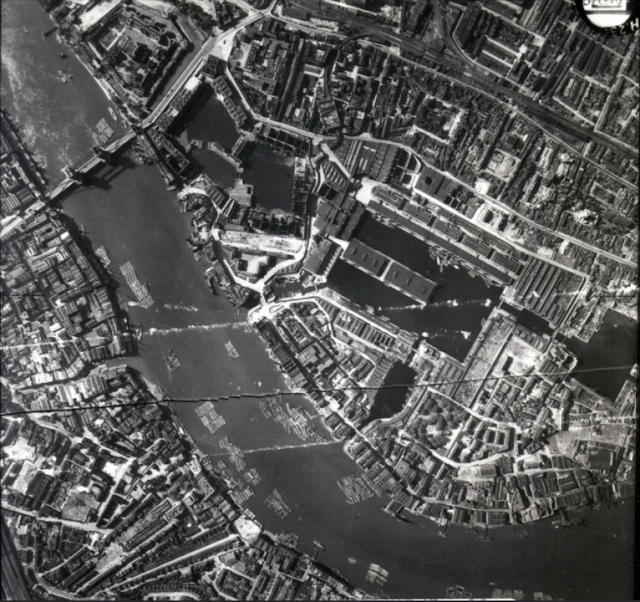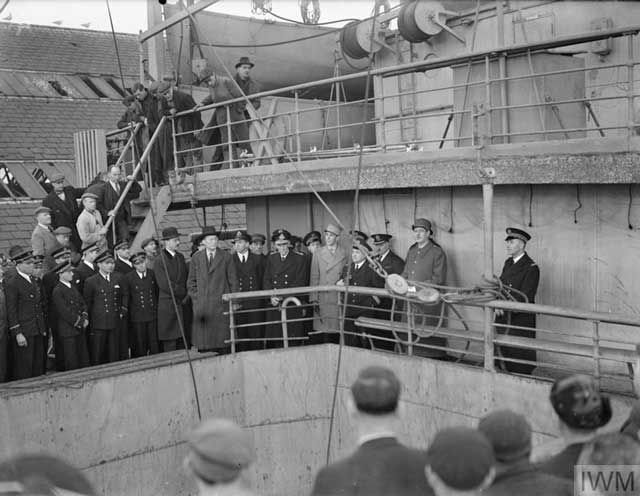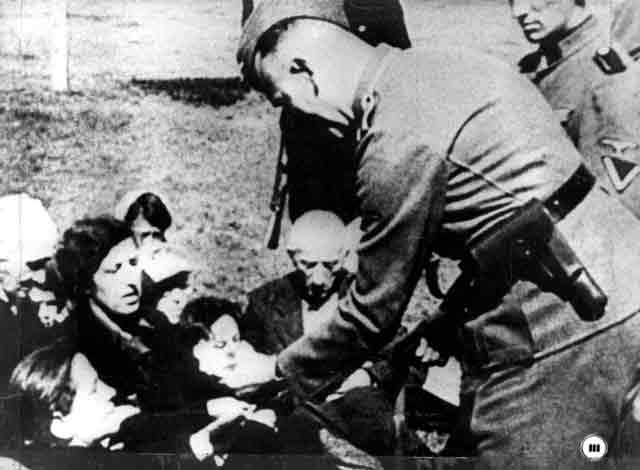Wednesday 18 June 1941
 |
| "Australian pilots of No. 452 Squadron relax outside their dispersal hut at Kirton-in-Lindsey, 18 June 1941." © IWM (CH 2883). |
Syrian/Lebanon Campaign: At 20:30 on
18 June 1941, the 5th Indian Brigade start heading twelve miles north toward Damascus. This begins the Battle of Damascus, perhaps the defining event of Operation Exporter.
After hand-to-hand fighting, the Indian troops take Mezzeh, on the Damascus-Beirut road about three miles west of Damascus. This accomplishes the major goal of cutting communications between the two cities. The Indian troops are now to head east and take Damascus. That is the plan, at least.
However, the Vichy French destroy their convoy of anti-tank guns and other supplies. The Vichy French troops then put pressure on the Indian troops at Mezzeh with Renault R35 tanks even though the town was supposed to be merely a stepping-stone to a further advance on Damascus. The day ends with the Indian troops desperately trying to defend Mezzeh rather than advancing further north.
Vichy French destroyers Guepard and Valmy sortie out of Beirut Harbor and bombard the advanced Australian positions at Sidon. They don't tarry long, however, because the Royal Navy is nearby.
Overhead, six Gloster Gladiators bounce a formation of Vichy French Dwoitine D.520 fighters. The Gladiator biplanes shoot down two of the French planes over Kissoue. These apparently are the final two claims by Gloster Gladiator pilots of World War II.
The fierce Vichy French resistance has caused more British and Australian effort than anticipated. This has caused some command difficulties as British General Henry Maitland Wilson has retained sole command at the King David Hotel in Jerusalem. For a simple campaign, such a command arrangement would have sufficed, but the French are showing signs of digging in. Thus, Australian Lieutenant General Thomas Blamey, Deputy Commander in Chief, Middle East Command, gives tactical authority to Lieutenant General John Lavarack General I Corps.
Behind the scenes, the Vichy French already see how things are going and quietly open negotiations with the British through the American Consul-General in Beirut. The Vichy government asks what terms the British and Free French would accept.
European Air Operations: During the day, RAF Bomber Command sends a Circus mission (6 bombers with heavy fighter escort) over Bois de Licques. A major action takes place in which the RAF claims 10 fighters for the loss of four.
After dark, RAF Bomber Command attacks Bremen with 100 bombers. The RAF also sends 57 bombers to attack the German cruisers at Brest without success.
 |
| London Docks, 18 June 1941. |
Battle of the Atlantic: U-138 (Oblt.z.S. Franz Gramitsky), on its fifth patrol and operating west of Cadiz, is sunk in a depth-charge attack by Royal Navy destroyers HMS Faulknor, Fearless, Foresight, Forester, and Foxhound. The submarine broaches the surface before it goes down long enough for the crew to scuttle it and for the entire 27-man crew to escape and survive the day to become POWs aboard the Faulknor. U-138 has sunk six ships totaling 48,564 tons and damaged one ship of 6,993 tons.
The lookouts on U-552 (KrvKpt. Erich Topp), on its third patrol out of St. Nazaire and operating about 150 nautical miles (280 km) northwest of Malin Head, spot a convoy. At 03:28 it torpedoes 10,948-ton British transport Norfolk. The freighter takes over an hour to sink and requires two more torpedoes, at 04:19 and 04:38. There is one death, the 70 survivors are picked up by HMS Skate. After the attack on Norfolk, U-552 attempts to shadow the convoy and bring in a wolf pack but the convoy escorts drive it off.
Polish destroyer Kujiwiak, just commissioned, is attacked by the Luftwaffe. There is one fatality from an exploding ammunition locker, but otherwise, the damage from the machine-gun fire of the German planes is minor.
British 6-ton fishing trawler Doris II hits a mine and sinks just off Sheerness. Both men on board perish.
Convoy SL-78 departs from Freetown bound for Liverpool.
Royal Navy minesweeping trawler HMS Romeo (Skipper William R. H. Stewart) is commissioned.
US Navy escort carrier USS Copahee and submarine Peto are laid down.
U-753 (Korvettenkapitän Alfred M. von Mannstein) is commissioned.
 |
| US Navy destroyer USS Gleaves underway, 18 June 1941. Note the U.S. Navy camouflage (National Archives NAID 513043). |
Battle of the Mediterranean: The British re-establish their positions after the failed Operation Battleaxe. British 7th Armored Division and Indian 4th Infantry Division have withdrawn to their original positions and, in some cases, behind them.
The RAF bombs Benghazi. During air battles, the Bf 109s of I,/JG 27 shoot down three Brewster Buffaloes. Ace Hans-Joachim Marseille requests and receives medical leave in Berlin.
The Royal Navy makes a supply run to Mersa Matruh, sending troopship Glenroy and net-layer Protector. They carry troops, gasoline and other supplies for the retreating British troops.
Spy Stuff: A German defector tells the Soviets that Operation Barbarossa will begin at 04:00 on 22 June. During warfare, such a warning would be given great credence, but this warning is brushed off because it is a time of peace. Another warning from the Soviet embassy in London also is filed.
 |
| Signing the German/Turkey Treaty of Friendship, 18 June 1941. |
German/Turkish Relations: While Hitler ideally would like Turkey to join the war on its historic enemy Russia, he realizes that is not going to happen. However, he gets the next-best thing today when Turkey signs a ten-year non-aggression pact (Türkisch-Deutscher Freundschaftsvertrag) with Germany. German ambassador to Turkey Franz von Papen signs on behalf of the Reich, while Turkish Minister of Foreign Affairs Şükrü Saracoğlu signs for Turkey. Germany, of course, has a similar pact with the Soviet Union.
German/Soviet Relations: Soviet Ambassador to Germany Vladimir Dekanozov suddenly requests an audience with the Foreign Ministry. Hitler flies into a panic and fears that the Soviets have uncovered his invasion plans. The last thing he wants is some desperate offer made to try to stop Operation Barbarossa when it is in the final stages of preparation. He spends a long time discussing the matter with Foreign Minister Joachim Ribbentrop and his adjutants Engel and Hewel. They decide that Hitler and Ribbentrop need to "disappear" for a few days to avoid any awkward questions. They even consider fleeing to Berchtesgaden.
However, Dekanozov shows up unannounced at the Foreign Ministry at 18:00 on the 19th, makes some small-talk, transacts some mundane business, cracks a few jokes, and leaves. Everyone then breathes a huge sigh of relief and Hitler stays in Berlin. It is probably the most uncomfortable Hitler has been during the entire war.
 |
| Filmwoche Magazine, 18 June 1941. |
German/Romanian Relations: Hitler meets with Ion Antonescu and lets him in on the details of the "great secret" Operation Barbarossa, including the opening date.
Japanese/Dutch Relations: The Japanese terminate their attempts to secure all of the oil and other output from the Dutch East Indies. They state:
The reply of the Netherlands of June 6 is not only very unsatisfactory but asserts in connection with the question of the acquisition of essential materials and goods, to which Japan attaches importance, that their quantities may be decreased at any time to suit their own convenience.
 |
| Luftwaffe reconnaissance of Münsterwalde, 18 June 1941 (Federal Archive, Bild 196-02278). |
German Military: The Luftwaffe continues its reconnaissance flights over the Soviet Union. One at the Soviet Koshka Yavr airbase 25 km southeast of Zapolyarny in the Murmansk Oblast comes under anti-aircraft fire. German troops are assembling across the border in Finland to invade the Soviet Union and try to seize the port of Murmansk.
The Kriegsmarine lays mines in the Baltic
General Halder confers with the Romanian Minister of War and tours the "front."
 |
| Luftwaffe reconnaissance over Neuenburg, 18 June 1941 (Federal Archive, Bild 196-02378). |
US Military: President Roosevelt meets with Secretary of the Navy Frank Knox and William "Wild Bill" Donovan. They talk about setting up a new intelligence organization based upon the British MI6, which Donovan studied during his recent European visit. This will become the Office of Strategic Services, or OSS, which will morph into the Central Intelligence Agency, or CIA.
The US Navy concludes Pacific Fleet Exercise No. 1 off the coast of California.
Soviet Government: Premier Joseph Stalin, completely unruffled by the mounting piles of warnings on his desk about a coming German invasion, leaves Moscow on a vacation down south.
British Government: King George and Queen Elizabeth tour munitions factories and shipyards in Tyneside.
 |
| Royal Visit by King George VI and Queen Elizabeth to Tyneside, 18 June 1941. |
British Homefront: Perhaps in an effort to boost morale, the government has decided to release some information about radar (known in England as "radiolocation technology"). It appears in the press today.
American Homefront: Felix Frankfurter, Associate Justice of the Supreme Court, gives the
Commencement address at Radcliffe College, Cambridge, Massachusetts. He gives a rationale for the war:
One of the most current of these evasions of thought is that "war never settles anything." The Civil War settled slavery. This war will settle the quality of your lives and your children's lives. It simply is not true that war never settles anything. I respect the convictions of a conscientious objector to war and I believe I understand the philosophy underlying Gandhi's non-resistance. But the relentless choice events may force on every individual cannot be met by such a fair-sounding pernicious abstractions as that "war never settles anything.
Boxer Joe Louis knocks out Billy Conn in the 13th round at the Polo Grounds in New York City. He thus defends his World Heavyweight Boxing title. It is his first serious defense after a string of "bum of the month" opponents.
New York Yankees Centerfielder Joe DiMaggio extends his record club-record hitting streak to 31 games with a single off White Sox pitcher Thornton Lee.
 |
| RCAF 1941 Chevrolet staff car with a flag, 18 June 1941. (Library and Archives Canada Photo, MIKAN No. 3581798). |
June 1941 June 1, 1941: Farhud PogromJune 2, 1941: Massacres on CreteJune 3, 1941: Kandanos MassacreJune 4, 1941: Kaiser Wilhelm Passes AwayJune 5, 1941: Death in ChungkingJune 6, 1941: Hitler's Commissar OrderJune 7, 1941: Commandos Strike at PessacJune 8, 1941: British Invade Syria and LebanonJune 9, 1941: Litani River BattleJune 10, 1941: British Take AssabJune 11, 1941: Hitler Thinking Beyond RussiaJune 12, 1941: St. James AgreementJune 13, 1941: Lützow DamagedJune 14, 1941: Latvian June DeportationsJune 15, 1941: Operation BattleaxeJune 16, 1941: The Old LionJune 17, 1941: British Spanked in North AfricaJune 18, 1941: Turkey Turns Its BackJune 19, 1941: Cheerios IntroducedJune 20, 1941: Birth of US Army Air ForceJune 21, 1941: Damascus FallsJune 22, 1941: Germany Invades RussiaJune 23, 1941: A Soviet KV Tank Causes HavocJune 24, 1941: Kaunas and Vilnius FallJune 25, 1941: Finland Declares WarJune 26, 1941: Bombing of KassaJune 27, 1941: Encirclement At MinskJune 28, 1941: Minsk FallsJune 29, 1941: Brest Fortress FallsJune 30, 1941: Mölders Becomes Top Ace2020










































